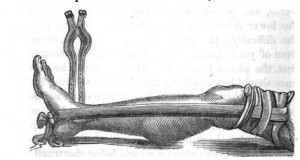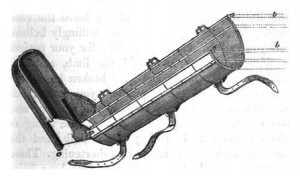Moniker/Name: Brenda
Your Question: What medicines, herbal or otherwise, were used primarily in the regency era? For instance, was there a ‘go to’ solution for stomach ailments, headaches, muscle aches? Also, could someone survive broken bones if they were really bad breaks? I am thinking of a crushed bone or compound fracture.
Source of Question: Just curious
Thank you Brenda for your wonderful and interesting questions!
First, about broken bones…
Manuals and other reference books from the Regency era indicate that tending broken bones were a common problem with both homegrown knowledge and physician science for the setting of all types of fractures. Undoubtedly, the success of the remedy entirely depended on the skill of the doctor or attendant (in some cases farriers/vets, midwifes, or others were all that were on hand).
Although rudimentary by today’s standards, splints, wooden casts, and plaster techniques were available to the doctors of the Regency for administering to broken bones, setting, and keeping immobile while the bones mended.

 (From: The principles of surgery: as they relate to wounds, ulcers, fistulæ, aneurisms, wounded arteries, fractures of the limbs, tumors, the operations of trepan and lithotomy. Also of the duties of the military and hospital surgeon, Sir Charles Bell, 1826)
(From: The principles of surgery: as they relate to wounds, ulcers, fistulæ, aneurisms, wounded arteries, fractures of the limbs, tumors, the operations of trepan and lithotomy. Also of the duties of the military and hospital surgeon, Sir Charles Bell, 1826)
Sir Charles writes on compound fractures, warning of fever, delirum and the many steps to assure the patients comfort and healing. Likely, he tells us, the fever and delirum will last for eight to ten days during which the doctor will need to be present to dilate the wound, stretch the bone, and reduce the bone protrusions. After the fever breaks into a chill, warm flannels and warm wine or cordial, plus a little laudanum, will help soothe the invalid.
He cautions that bleeding, if necessary, should only occur after the physician is able to obtain a steady pulse “though the vulgar after every accident are in haste to bleed.”
In the The London Medical and Physical Journal, Volume 10 (1803) another physician describes similar concern with country doctoring:

From reading many of these contemporary resources, it is evident that much was learned in the battle fields where all type of serious wounds needs must be triaged and treated in rustic setting. Also, breaks are an inevitable occurence of the human condition, likely resulting in non-professional experience with bone-setting among many country dwellers.
So, while there was knowledge enough to help minimize mortality among patients with compound fractures, substandard medical care (an age old problem) or vigorous inexperience could result in further injury and even death. In other words, compound fractures or crushed bones resulting in death was not a foregone conclusion, but the survival of the injured party relied on luck, constitution and well-informed medical attention.
As for medicinal herbs, I will assume (for my sanity) that you are curious about those sold by herbalist and native to the UK. Using Culpeper’s Regency contemporary encylopedia of herbs, I have compiled a shortlist of the most common medicinal plants. For more in depth and a variety of other herbs, check out the online Culpeper “The Complete Herbal.”
| Common Herb and uses in Regency era England |
Commonly grown… |
Bazil (Basil)
- Used dried as snuff to relieve headaches and colds.
- Culpeper said it “expels both birth and after-birth.”
- Also used as a strewing herb.
|
In gardens, harvested late in summer. |
Camomile (Chamomile)
- Infused as a tea for indigestion and gas, and “all the pains and stitches in the side”.
- Strewing herb and insect repellent.
- Added to bath it was used as a muscle relaxant, to reduce swelling, and stimulate bodily functions.
- Syrup made of the juice of Camomilein white wine was remedy against the jaundice and dropsy.
- The flowers boiled in lye, are good to wash the head, and comfort both it and the brain.
- The oil made of the flowers much used against all hard swellings, pains or aches, shrinking of the sinews, or cramps, or pains in the joints.
|
Indigenous to England and Western Europe. Was cultivated for medicinal purposes primarily in Surrey. |
Feverfew
- For “female hysteria,” melancholia and
- Constipation.
- First noted for its anti-inflammatory properties by Greek Herbalist, Dioscorides.
- Reduce fever and to treat headaches, arthritis
|
Feverfew was native to Eurasia and then cultivated worldwide. |
Garlic Chives
- This was anciently accounted the poor man’s treacle, it being a remedy for all diseases and hurts (except those which itself breed.)
- Provokes urine, and women’s courses
- Helps heal biting of mad dogs and other venomous creatures
- kills worms in children
- cuts and voids tough phlegm
- purges the head, helps the lethargy
- good preservative against, and a remedy for any plague, sore, or foul ulcers;
- takes away spots and blemishes in the skin,
- eases pains in the ears
- also held good in hydropick diseases, the jaundice, falling sickness, cramps, convulsions, the piles or hæmorrhoids, or other cold diseases.
- Its heat is very vehement, and all vehement hot things send up but ill-favoured vapours to the brain. In coleric men it will add fuel to the fire; in men oppressed by melancholy, it will attenuate the humour, and send up strong fancies, and as many strange visions to the head; therefore let it be taken inwardly with great moderation; outwardly you may make more bold with it.
|
Related to the onion, English garlic was most prevalent as food stuff for working classes well into the 19th century. |
Lavender
- Falling sickness or giddiness of the brain.
- insect repellant.
- Often combined with water or doused on clothing for both perfume and to help fainting or nausea.
|
In the mint family, different species are found worldwide. Most common in temperate climates. |
Lovage Then
- Diuretic and carminative action for disorders of the stomach and feverish attacks, especially for cases of colic and flatulence in children
- Noted for exciting perspiration and opening obstructions.
- An infusion of the root was recommended for gravel, jaundice and urinary troubles
- an infusion ‘being dropped into the eyes taketh away their redness or dimness
- The distilled water is good for quinsy if the mouth and throat be gargled and washed therewith
- The decoction drunk three or four times a day is effectual in pleurisy
- The leaves bruised and fried with a little hog’s lard and laid hot to any blotch or boil will quickly break it.’
|
Not considered to be indigenous to Great Britain, and when occasionally found growing apparently wild, it is probably a garden escape. Native to the Mediterranean region. |
Mint
- “a marvelous wholesome” for the stomach
- “it stayeth the hicket” [hiccup]
- good against watery eyes
- a sure remedy for children’s sore heads.
- dry up excess milk in nurses and, taken in wine, would help women in childbearing.
- “healing, binding and drying” and with vinegar said to stop bleeding.
- Cures gum or mouth sores
- soothes head and memory
- prevents “ill-savored breath”
- with salt good for wounds from the “biting of a mad dog.”
|
Grows best in wet environments, perennial. Many varieties native worldwide. |
Rosemary
- helps all cold diseases both of the head, stomach, liver, and belly.
- The decoction thereof in wine, helps the cold distillations of rheum into the eyes
- giddiness or swimmings therein, drowsiness or dullness of the mind and senses like a stupidness, the dumb palsy, or loss of speech, the lethargy, and fallen- sickness, to be both drank, and the temples bathed therewith.
- It helps the pains in the gums and teeth, by rheum falling into them, not by putrefaction, causing an evil smell from them, or a stinking breath.
- helps a weak memory, and quickens the senses.
- comfortable to the stomach in all the cold griefs thereof, helps both retention of meat, and digestion, the decoction or powder being taken in wine.
- It is a remedy for the windiness in the stomach, bowels, and spleen, and expels it powerfully.
|
Originally Mediterranean, flowers in spring and summer in temperate climates, but the plants can be in constant bloom in warm climates; flowers are white, pink, purple or deep blue |
Sage
- useful against snakebite
- turn hair black
- provokes urine, brings down women’s courses
- stays the bleeding of wounds and cleanses foul ulcers.
- for all pains of the joints, whether inwardly or outwardly
- the lethargy such as are dull and heavy of spirit, the palsy;
- for the diseases of the chest or breast.
- Sage is of excellent use to help the memory, warming and quickening the senses;
- “Gargles likewise are made with Sage, rosemary, honey-suckles, and plantain, boiled in wine or water, with some honey or allum put thereto, to wash sore mouths and throats, cankers, or the secret parts of man or woman, as need requires”
- boiled to bathe the body and the legs in the Summer time, especially to warm cold joints, or sinews, troubled with the palsy and cramp, and to comfort and strengthen the parts.
|
Perennial, evergreen subshrub, with woody stems, grayish leaves, and blue to purplish flowers. It is a member of the family Lamiaceae and is native to the Mediterranean region, though it has naturalized in many places throughout the world. |
Thyme
- a noble strengthener of the lungs; neither is there scarce a better remedy growing for that disease in children which they commonly call the Chin- cough, than it is.
- It purges the body of phlegm, and is an excellent remedy for shortness of breath.
- It kills worms in the belly
- provokes the terms, gives safe and speedy delivery to women in travail, and brings away the after birth.
- An ointment made of it takes away hot swellings and warts
- helps the sciatica and dullness of sight
- takes away pains and hardness of the spleen.
- Tis excellent for those that are troubled with the gout.
- eases pains in the loins and hips.
- The herb taken any way inwardly, comforts the stomach much, and expels wind.
|
Thyme is best cultivated in a hot, sunny location with well-drained soil. It is generally planted in the spring, and thereafter grows as a perennial. It can be propagated by seed, cuttings, or by dividing rooted sections of the plant. It tolerates drought well. |
Yarrow
- An ointment of them cures wounds;
- it stops the terms in women
- the ointment of it is not only good for green wounds, but also for ulcers and fistulas, especially such as abound with moisture.
- It stays the shedding of hair, the head being bathed with the decoction of it; inwardly taken it helps the retentive faculty of the stomach:
- it helps the gonorrhea in men, and the whites in women,
- helps such as cannot hold their water;
- and the leaves chewed in the mouth eases the tooth-ache
|
It is native to temperate regions of the Northern Hemisphere in Asia, Europe, and North America. |
Like this:
Like Loading...

 (From: The principles of surgery: as they relate to wounds, ulcers, fistulæ, aneurisms, wounded arteries, fractures of the limbs, tumors, the operations of trepan and lithotomy. Also of the duties of the military and hospital surgeon, Sir Charles Bell, 1826)
(From: The principles of surgery: as they relate to wounds, ulcers, fistulæ, aneurisms, wounded arteries, fractures of the limbs, tumors, the operations of trepan and lithotomy. Also of the duties of the military and hospital surgeon, Sir Charles Bell, 1826)








